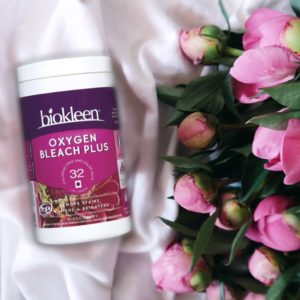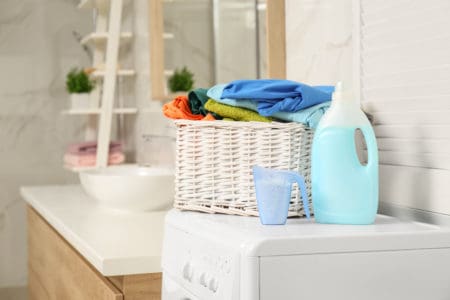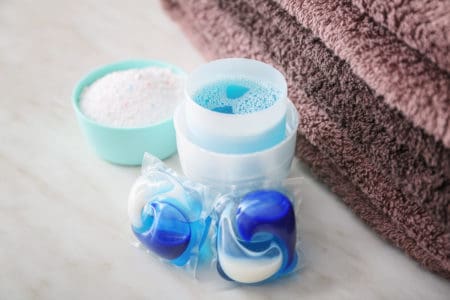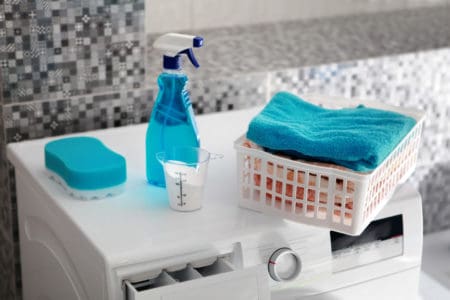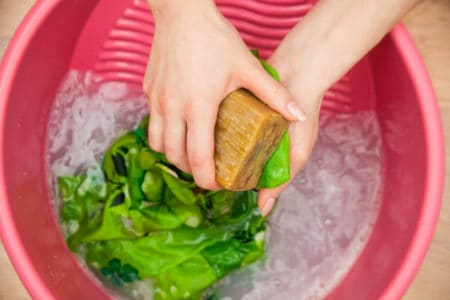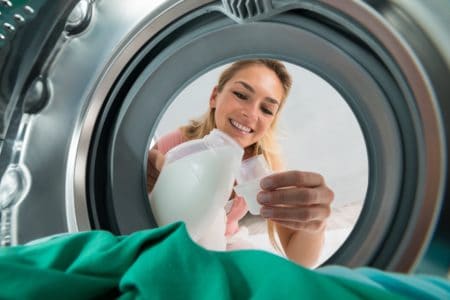Oxygen bleach is an effective cleaning product. In fact, it is just as effective as chlorine bleach, but it’s better for you and the environment.
We’ll teach you how to use oxygen bleach in various areas of the home. Whether you need to use it for laundry, removing stains, or cleaning fences — we’ve got your back!
Key Takeaways
- Oxygen bleach is a non-toxic, color-safe alternative to chlorine bleach, based on sodium percarbonate.
- For laundry, mix oxygen bleach with warm water before adding it to the machine drum, detergent, and clothes.
- While not as strong as chlorine bleach, oxygen bleach has sterilizing properties but may not disinfect as effectively.
- Do not use oxygen bleach on delicate fabrics like wool, leather, or silk, and avoid garments with wooden buttons.
How Does Oxygen Bleach Work?
Oxygen bleach, usually found in powder form, is based on sodium percarbonate. When sodium percarbonate contacts water, it breaks down into sodium carbonate and hydrogen peroxide.
The hydrogen peroxide becomes the active oxidizing agent, breaking down and removing stains. Hydrogen peroxide is a color-safe stain remover. It breaks up the colorful chemical bonds of a stain, making it invisible so that your clothes look as good as new (1).
Does Oxygen Bleach Kill Bacteria?
It’s common knowledge that chlorine bleach kills bacteria (2). That’s why so many people use it to clean and disinfect their homes and laundry. But if making the switch to oxygen bleach, it’s important to know that oxygen bleach does not disinfect in the same way chlorine bleach does.
Oxygen bleach creates hydrogen peroxide, which has sterilizing properties (3). However, most companies that sell oxygen bleach don’t have it registered as a disinfectant. Because oxygen bleach is mixed with water, it’s diluted, which can minimize any disinfecting ability.
Powder vs Liquid Oxygen Bleach
Oxygen bleach comes in both a powder and liquid form, but powder is more popular.
Powdered oxygen bleach has a longer shelf life than liquid (4). Plus, powdered oxygen bleach is more concentrated, so it will go further and last longer than liquid. In contrast, the more diluted liquid version is slightly less potent.
It’s up to you which medium you prefer, as well as what your machine handles better. But overall, we recommend powder oxygen bleach.
How Do You Mix Oxygen Bleach?
Oxygen bleach works best at warm temperatures so that the powder dissolves. However, if you want to use a cold wash — you can mix the oxygen bleach in advance.
Just mix the powder in a cup with hot water before adding it to the drum of your machine. Then add your clothes, choose your cycle, and press “start.”
You can also use oxygen bleach with other products such as washing soda or your regular detergent.
Keep In Mind
What Is the Difference Between Bleach and Oxygen Bleach?
Chlorine bleach and oxygen bleach are very different but perform similarly.
Chlorine bleach is a combination of chlorine gas and sodium hydroxide. This creates sodium hypochlorite (5). It’s then diluted with water before being bottled and sold.
Chlorine bleach removes stains in laundry and around the house, disinfects surfaces, and is used in swimming pools to kill bacteria. However, it can have toxic side effects, even when used in small amounts. It’s known to irritate skin, eyes, and lungs (6).
Oxygen bleach is a non-toxic alternative. Plus, unlike chlorine bleach, it’s color-safe as it doesn’t strip fabrics of their color (7). One drawback is that it won’t disinfect to the same degree as chlorine bleach.
How to Use Oxygen Bleach
Before you get to using your oxygen bleach, here are a few things to note that will make the experience easier and more effective.
- Mix it with water: If you’re using oxygen bleach in the laundry, you don’t need to dilute it beforehand. However, some people like doing so to make sure it’s fully dissolved. Also, oxygen bleach only works when mixed with water. So if you’re using it to treat stains or clean around the house — you need to mix it first.
- Always follow package instructions: Each brand formulates its oxygen bleach a little differently. Make sure to always read and follow the package instructions to know how much to use and how best to use it.
- Safe on whites and colors: Oxygen bleach, unlike chlorine bleach, is safe on whites and colors. Don’t be scared to use this on your striped t-shirt or polka dot skirt. It can help to brighten and rejuvenate all colors of the rainbow.
- Not safe on all fabrics: Oxygen bleach should never be used on wool, leather or silk garments as well as garments with wooden buttons.
How to Use Oxygen Bleach for Laundry
As a Pre-Soak
You can use oxygen bleach as a pre-soak in the laundry for removing tougher stains.
- Get a separate container: You can use a sink if you like, but we recommend a separate basin since we’re going to soak the garments for a while.
- Mix: Mix the recommended amount of oxygen bleach and warm water together until fully dissolved.
- Add clothes: Submerge the stained garments into the water.
- Soak: Let it soak for up to eight hours.
- Wash: Wash the garments as normal in the machine. You can add more oxygen bleach here following the steps above for an extra boost.
For a Wash Cycle
Using oxygen bleach in your laundry can brighten clothes, whiten whites, and remove stains.
- Read the package instructions: The instructions per brand will tell you how much of the product to use for your load. Make sure to follow this.
- Mix: If using a cold wash, mix the oxygen bleach with water in a cup until fully dissolved. With a warm or hot wash, you shouldn’t need to do this.
- Add the oxygen bleach: Even if you have a detergent dispenser, you need to add the oxygen bleach to the drum of the machine before adding clothes. This allows the water to target the oxygen bleach first and dilute it well.
- Add detergent: Oxygen bleach can be used in conjunction with your normal detergent. In fact, detergent can help to remove the stain residue that oxygen bleach lifts from your clothing. Add this to your drum or detergent dispenser.
- Add clothes: Now you can add the clothes to the drum, directly on top of the oxygen bleach.
- Wash: You’re ready to start the cycle. Choose the desired temperature and appropriate cycle setting and get those clothes clean.
How to Use Oxygen Bleach for Stain Removal
Oxygen bleach can remove stains on surfaces, such as carpets.
- Read the package instructions: Read the product instructions for information on how much oxygen bleach and water to mix for an effective solution.
- Mix: Mix the bleach and water together, thoroughly dissolving.
- Remove stain: Before applying the solution, remove as much of the excess stain as possible.
- Apply: Apply the solution to the stain, saturating it.
- Soak: Let it soak for up to five minutes. Do not allow the solution to dry.
- Blot: With a clean white towel, blot at the stain.
- Repeat: If the stain persists, repeat this process until it is removed.
- Rinse: Rinse the area with clean cold water and blot until dry.
Top Tip
How to Use Oxygen Bleach for Cleaning
To use oxygen bleach for general cleaning around the home on counters or bathrooms, follow these tips.
- Read the package instructions: Follow the manufacturer’s guidelines on how much oxygen bleach to mix with water. For some surfaces, like grout, it might require more since these stains are tougher.
- Mix together: In a cup, bowl or basin, mix together the solution until thoroughly dissolved.
- Pour: Slowly pour the solution directly onto the surface.
- Work it in: Work in the solution with a cloth, sponge, or brush, spreading it evenly across the area.
- Let it stand: For between five and 30 minutes, let the solution stand.
- Scrub: During this time, if an area needs to be scrubbed because of a tough stain, do so now.
- Don’t let it dry: Do not let the solution dry. Keep an eye on it to make sure it’s staying wet. If it starts to dry before 30 minutes is up, move onto the next step.
- Rinse: Soak a cloth in cold clean water and rinse the area.
- Dry: With another dry, clean cloth, blot the area until it’s dry.
How to Use Oxygen Bleach for Mold Removal
Before you start removing mold and mildew with oxygen bleach, you need to create a different solution, depending on where you’re cleaning.
For indoor surfaces: Mix ¼ scoop of oxygen bleach with two cups of hot water.
For fabrics: Mix ½ scoop of oxygen bleach with a gallon of hot water.
For outdoor surfaces: Mix one scoop of oxygen bleach with a gallon of hot water.
- Mix: Mix your solution together thoroughly until the oxygen bleach has dissolved.
- Apply: Use a cloth or sponge to apply the solution directly to the mold.
- Wait: Wait between 10 and 15 minutes for the solution to soak in and attack the mold.
- Blot: Blot the area with warm water, rinsing away the oxygen bleach solution.
- Dry: Blot to dry thoroughly to make sure that mold doesn’t return.
How to Use Oxygen Bleach to Clean Fences
- Mix: Combine ¼ scoop of oxygen bleach with four cups of water. Increase the quantities depending on the size of your fence. Dissolve thoroughly.
- Spray: Use a garden hose to spray your fence until it’s wet.
- Apply: Use a paintbrush to generously apply the oxygen bleach solution to your fence. Go section by section.
- Wait: Once a section is complete, wait five minutes for the solution to set in. If there is a lot of mold or mildew, you can wait up to 15 minutes.
- Spray: Spray the fence again using your garden hose.
- Scrub: Use a scrubbing brush to remove any mold or mildew that has been loosened.
- Spray: Spray the section again using the hose.
- Repeat: Repeat for every section of the fence.
Caution
Other Uses of Oxygen Bleach
Although we’ve shared a few uses for oxygen bleach already, it doesn’t end there!
- Cleaning tools: From time to time, you should clean your cleaning tools — such as mop heads and scrubbing brushes. Mix ¼ scoop of oxygen bleach and hot water in a bucket and soak your tools in it for 15 minutes.
- Clean grout: Mix three tablespoons of oxygen bleach with two gallons of warm water in a bucket. Use a cloth or sponge to apply the solution to grout lines. Let it sit for 15 minutes. Rinse with clean water.
- Cloth diapers: Oxygen bleach is gentle but effective on cloth diapers. Add the oxygen bleach to your machine for every wash. For tougher stains, soak the cloth diapers in a mix of four tablespoons of oxygen bleach and warm water for one to six hours.
- Clean your trash cans: Trash cans get really yucky. Mix one cup of oxygen bleach with a gallon of water. Use a cloth or scrub brush to soak up the solution and then apply it to your garbage can. You could also pour it right into the garbage can and let it soak for a few minutes. Scrub well and rinse with clean water.
- Remove labels from jars: Fill your sink with hot water and add a scoop of oxygen bleach. Mix thoroughly before soaking the jars in the solution for an hour. When you return, the labels should be released and are maybe even floating in the water. If not, use a cloth to loosen them from the glass.
- Clean the deck and patio: Make a solution of oxygen bleach using one tablespoon per cup of water. Pour it into a spray bottle. Soak the patio or deck with the solution and let it stand for 30 minutes without letting it dry. If it begins to dry, add more solution. Scrub with a brush and rinse with clean water.
- Clean your fridge: Empty the food from your fridge first. Mix together a cup of water per tablespoon of oxygen bleach. Use a cloth to apply the solution to your fridge to remove mold, mildew, and other stains. Soak for 10 minutes, then wipe clean.
FAQs
Bleach It With Oxygen
No matter what household chore you need to tackle, oxygen bleach can help. It works for laundry, stain removal, cleaning carpets, cloth diapers, grout, cleaning tools, the patio, and much more.
Think about the power of chlorine bleach, but without the toxic chemicals. Just note that it won’t disinfect like chlorine bleach — and it can’t be used on silk, leather, or wool.
Overall, this is a top choice and a staple for many people. We recommend keeping a box in your cupboard. You never know when it will come in handy.
